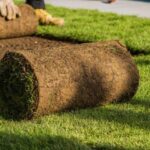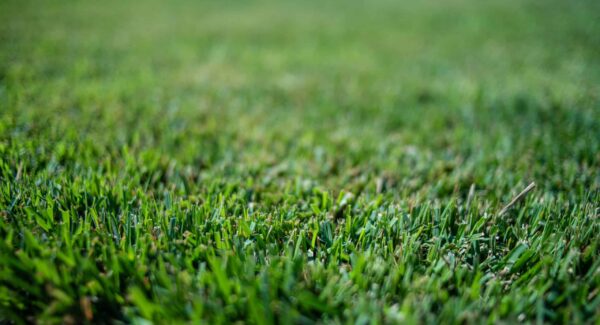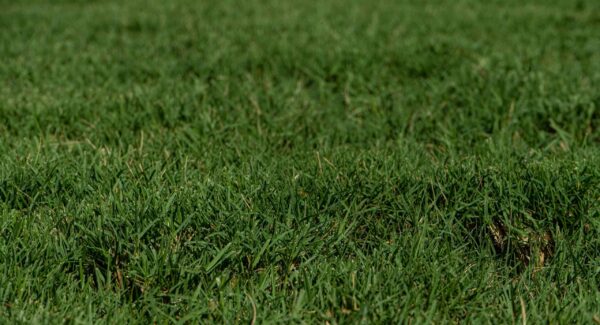What is Sod Landscaping?
Sod refers to pre-grown grass that comes in rolls with its root system and a layer of soil. These sod pieces are placed directly onto a prepared surface, creating an instant lawn and a neat green area.
Due to the speed and ease of installation, as well as the instant appearance, sod landscaping has become very popular for both residential properties and individual households. Instead of waiting weeks for the seeds to sprout and grow, the lawn can be used much faster.
Sod landscaping provides a uniform grass cover without gaps. There is no uneven growth, which can sometimes occur with seeded grass. Sod comes from cultivated fields that are often treated against weeds, reducing the chances of weed development compared to seeding.
The advantages of forming a lawn with sod are numerous, and some of them include:
- You get a lawn in one day
- Instant effect
- No mud
- The grass is uniform and dense
- The sensitive care phase (until the first sprouting) is skipped
In this text, we will strive to answer all the frequently asked questions about sod landscaping, so you will learn:
- What sod grass is
- How to design and create green areas using sod
- The benefits of sod
- What the installation process looks like
- Types of sod for different landscapes
- The costs of creating a lawn with sod
- The environmental benefits of sod landscaping

What is Sod?
Sod is pre-grown on farms specialized in its cultivation. It is essentially a lawn, a layer of grass that grows above the ground. The grass is typically dense and uniform, with healthy, green blades.
The roots are firmly intertwined with the soil layer beneath, allowing the grass to take root quickly when placed on a new surface. Thanks to this strong root network, the sod is flexible and can be easily handled during installation.
A well-developed root system makes sod resistant to trampling immediately after installation, making it practical for quick use, although traffic should be light during the first few weeks.
The grass’s soil remains attached to the roots, ensuring stability during transport and installation. This layer is usually not thick, but it is sufficient to allow the plant to root quickly in its new location.
Once the grass reaches maturity, it is cut into rolls or squares and transported to the buyer’s chosen location. This method allows households and commercial properties to install a fully-formed lawn quickly and easily.
Types of Sod and How to Choose Based on Climate and Soil Type
Texas’s most commonly chosen types are Bermuda, Zoysia, and St. Augustine.
St. Augustine
St. Augustine grass thrives best in subtropical conditions and coastal areas, so if you have sandy soil, St. Augustine will be a good choice for your lawn. This grass adapts well if you live in a region where the sun shines most days, and the climate is generally warm. Overall, it can adapt quickly and successfully to different soil types.
This grass loves the sun and boasts a rich, dark green color that can turn any lawn into a green oasis. Its deep green hue adds natural elegance to your space.
Although it loves the sun, it doesn’t require constant sunlight – it grows well in partially sunny areas, making it an excellent choice for yards with some shade.
Bermuda

Bermuda grass grows well in these areas due to its high salt tolerance, but considering its adaptability, it thrives in various locations and soil types, including clay soils.
Bermuda can spread quickly, and what’s truly fascinating about it is its drought tolerance. This means it won’t wilt even under intense sunlight and doesn’t require as frequent watering as other grasses to remain green, lush, and healthy.
It grows densely, creating a thick turf layer that looks great and is highly durable. This density and resilience make it ideal for areas that experience frequent foot traffic, such as sports fields and public parks.
Zoysia
Zoysia grass is adaptable and can grow in most soil types, including clay soils.
It shows exceptional adaptability, perfectly tolerating extreme heat and cold, unlike many other types of grass that struggle to withstand such conditions.
Its blades are a rich dark green and softer to the touch than many other grasses. Zoysia is suitable if you enjoy spending time on the grass and love feeling it under your bare feet. However, its softness doesn’t compromise durability, so you get a pleasant and robust lawn.
Another outstanding feature of Zoysia grass is its resistance to many diseases. Lawn disease problems can demand attention and investment, but Zoysia resists weather challenges and the most common lawn diseases.
What is Sod Landscaping?
When a lawn needs to be quickly established, laying sod is the best choice, as bare soil becomes a lawn in just a few hours and is usable after 15-20 days. This is already a sufficient motivation to create a neat yard and landscaping residential complexes.
Since sod is grown under controlled conditions, it usually contains fewer weed seeds than bare soil, resulting in a cleaner, weed-free lawn right from the start.
The Difference Between Seeding and Laying Sod
The primary differences between sod landscaping and traditional grass seeding lie in the method of lawn installation, the time needed for results, and the maintenance required in the early stages.
When you seed a lawn, you start from scratch. Grass seeds are directly sown into the ground and take several weeks to sprout. The lawn may take several months to fill in and achieve a mature look.
Sod requires regular watering during the first few weeks to establish the roots, but it is generally easy to maintain after installation. Weeds are minimal in the beginning because sod is grown under controlled conditions.
Seeding requires much more attention in the early stages. Grass seeds need to stay constantly moist to germinate, and new grass is fragile, so it needs to be protected from foot traffic.
Let’s take a closer look at the table:
| Aspect | Sod Landscaping | Traditional seeding |
| Instant results | Immediate, green lawn | Takes weeks to months to establish |
| Cost | More expensive | More cost-effective upfront |
| Maintenance | Low after establishment | High maintenance during early stages |
| Weed control | Minimal weeds | More prone to weeds initially |
| Erosion control | Provides immediate erosion control | No protection until grass establishment |
| Durability | Ready for use within a few weeks | Takes months to become durable |
| Flexibility | Limited grass species options | Wide variety of species to choose from |
Sod is the best choice if you’re looking for quick results and a durable lawn with minimal maintenance from the start, while seeding offers more flexibility and is cheaper upfront but requires more patience and attention.
Benefits of Sod Landscaping
 Sod provides an instant green lawn as soon as it’s laid, which is its first benefit for anyone still undecided about whether to go through with this process.
Sod provides an instant green lawn as soon as it’s laid, which is its first benefit for anyone still undecided about whether to go through with this process.
Sod is ideal for areas prone to erosion or slopes, as it immediately holds the soil in place, unlike seeding, where it takes time for the roots to establish.
Sod is more resilient and can handle more traffic, footfall, and pests in the early stages compared to newly seeded lawns. It generally requires less water for rooting than seeds, which must be constantly moist until they germinate and for several weeks afterward.
If you’re wondering whether sod has weeds, the answer is no. Sod is usually grown in ideal conditions, which reduces the chances of weed growth in the early stages.
Another great advantage is that sod landscaping can be done throughout the entire growing season. The best time is in the fall or spring, as the cool and moist weather encourages rapid root development.
Laying sod can be done during any month of the winter as long as the soil isn’t frozen. Installing it during the summer is the least favorable option, as it dries quickly due to higher temperatures and takes longer to recover from transplant shock due to extreme weather conditions.
Sod Installation Process
Unlike the pre-sowing preparation for seed planting, laying sod does not require the same level of soil quality, except that the ground should be settled, well-leveled, and free of any small debris.
The soil needs to be prepared before the sod is cut or purchased from a supplier, and it should be installed immediately. If the soil is poor in nutrients, it’s necessary to amend the soil. Amendments should be based on a recent soil nutrient analysis, and new sod should not be laid immediately after certain fertilizers and amendments are applied, such as nitrogen and compost.
The soil should also be tested for its pH level before installing sod. Most grass types grow best in slightly acidic soil with a pH between 6 and 7.5.
It’s recommended to have the sod delivered to your address the same day you are installing it. Installing it right after delivery ensures that the lawn remains fresh and hydrated.
Order 5 to 10% more than the calculated amount to cover specific areas like curves and edges.
Watering and Maintenance After Sod Installation
- Immediate watering: Begin watering the sod as soon as you have installed about 200 sq ft. The goal is to keep the soil beneath the sod consistently moist until the roots begin to establish. Water the lawn daily for the first two weeks, ensuring it gets about 1 inch per zone. After two weeks, gradually reduce the frequency of watering.
- Avoid foot traffic: Refrain from walking on the new lawn for at least 2-3 weeks until the roots establish themselves. Heavy foot traffic during this period can damage the sod and disrupt root development.
- Mowing: You can start mowing the lawn after it is well-rooted (usually after 2-3 weeks). Ensure that the mower blades are sharp to avoid tearing the grass. Do not cut over one-third of the blade length in a single mowing.
Which Type of Grass to Choose?
The choice usually comes down to warm-season or cool-season grasses, which you should select based on your climate and soil type. If you live in warmer regions, grasses like Bermuda, St. Augustine, or Zoysia are the best options due to their resistance to heat and drought. These grasses can endure long, hot summers, don’t require much watering and are easy to maintain.
Bermuda can handle foot traffic and recovers quickly if damaged; St. Augustine thrives even in shaded areas, while Zoysia is resistant to weeds and doesn’t need frequent mowing.
For those in cooler regions, Kentucky Bluegrass and Fescue offer excellent cold resistance and adaptability to various growing conditions.
Sod Landscaping for Residential vs. Commercial Properties

A lush lawn created by laying sod, combined with carefully maintained shrubs, flowers, and high-quality outdoor furniture, can quickly attract attention and draw in potential clients, customers, and visitors. A well-kept green area conveys professionalism, dedication, and pride.
The quick installation of sod allows for immediate greening, which is ideal for spaces that want to achieve an appealing look in a short time. Additionally, sod is highly resistant to wear and intensive use, making it crucial for areas with high foot traffic, such as business buildings and public parks.
Moreover, sod landscaping helps control erosion and retain soil, which is vital for preserving infrastructure in urban environments. They also contribute to the ecological balance by reducing heat in urban zones and filtering dust from the air.
Private homes
When it comes to sod landscaping in private homes, there are numerous advantages and benefits. First, maintaining and caring for it requires much less effort, and children will especially enjoy the soft grass as a playground for all-day fun.
The fact that sod can be laid at any time of the year and that you can enjoy the perfection of your yard in a short period is more than enough reason to opt for this choice. An instant lawn will bring joy to every family member.
If you ever want to organize an event in your yard but haven’t managed to establish a lawn yet, sod will be a smart and quick solution. In no time, you’ll have a well-kept landscape that will leave your guests speechless.
A green area purifies the air, creating a pleasant atmosphere for everyone present while increasing your property’s value.
Sod Landscaping Costs and Maintenance
The cost of sod is not universal and depends on several factors, including the type of grass chosen, the quality of the sod and soil, and the geographical characteristics of the purchase location.
In Texas, the average installation cost of sod ranges between $1.50/sq ft and $4.92/sq ft.
The price of sod varies depending on the type of grass. Common varieties such as Bermuda, St. Augustine, and Zoysia have different prices per square foot, typically ranging from around $0.50 to $.73. The total cost for a pallet of sod, averages between $220 and $325, which covers 400 to 450 square feet, not including the delivery and installation services.
Sod by Pallet, Half-pallet, and by Piece
Sod is usually sold in three main ways: by the pallet, half-pallet, and by the piece. Purchasing by the pallet is cost-effective for large projects, such as installing a new lawn or landscaping large areas.
For smaller projects or spot repairs, buying sod by the half-pallet or piece is practical. Each piece typically covers around 2.67 square feet; a half-pallet will cover 200-225 square feet.
How to Care for Newly Laid Sod
In the first few weeks after installation, practice regular watering. Once the grass has rooted, watering will be less frequent, but ensure it’s deep enough to encourage strong root development.
Mow the grass regularly to the recommended height for its type. Be careful not to cut more than one-third of the grass’s height in a single mowing. Add appropriate fertilizer according to the needs of your chosen grass type, following the recommended doses and schedule.
Tip: Regularly inspect your lawn and remove weeds promptly.
Environmental Benefits of Sod Landscaping

Sod helps cool the environment by reflecting the heat from the sun’s rays while simultaneously absorbing harmful pollutants from the air. This process releases fresh air into the surroundings, allowing you to breathe cleaner and healthier air.
During hot summer days, a sod lawn will be noticeably cooler than stones and up to fifteen degrees cooler than bare soil. This is because the grass absorbs carbon dioxide and releases oxygen, further cooling the air and creating a more pleasant atmosphere. The air quality is improved, making it healthier and noticeably fresher.
Sod also stabilizes the soil, as the dense root system of the grass keeps the soil in place. This reduces the risk of erosion caused by wind and rain, which is particularly important if your yard has slopes. Less erosion means nutrients and organic material remain in the soil, contributing to healthier vegetation.
What are the other benefits of a well-maintained lawn in urban areas? Green lawns effectively absorb noise and reduce noise pollution. Grass also reduces the amount of dust in the air by capturing dust and dirt particles carried by the wind.
Conclusion
Laying sod provides an instantly neat, healthy, and elegant lawn, making it suitable for both residential and commercial use. Sod requires less soil preparation, and can be laid year-round, which is a significant advantage.
Once installed, the lawn can be used within just 15 days, unlike seeding, which may require several weeks for the lawn to develop its characteristic look.
Regular fertilization, watering, and mowing are the key factors in keeping your yard looking impeccable. The encouraging part is that lawns formed by sod installation require less maintenance than those grown from seed.
Any uncertainties you may have can be resolved with the help of experts from The Grass Outlet. Don’t hesitate to call us and schedule a meeting.





